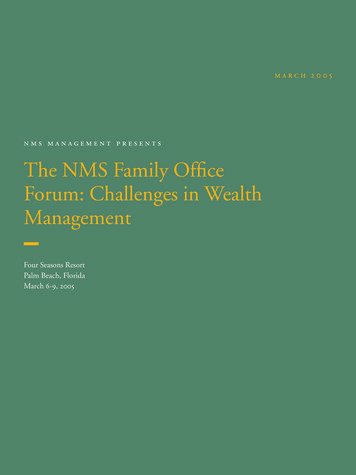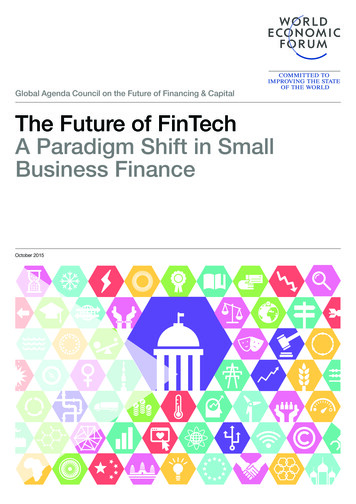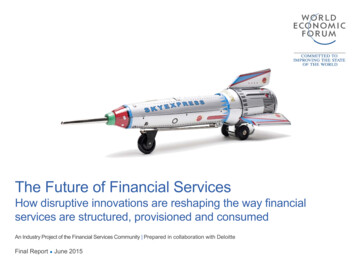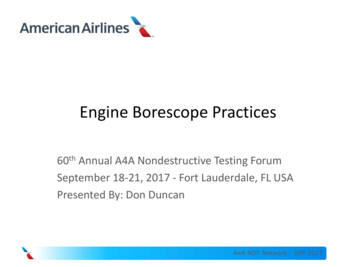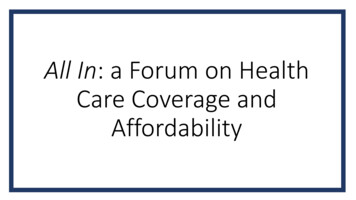
Transcription
All In: a Forum on HealthCare Coverage andAffordability
New Insurance Options
Gary ClaxtonKaiser Family Foundation3
Brian WebbNational Association of InsuranceCommissioners4
Jessica AltmanPennsylvania InsuranceDepartment5
New Insurance Options
State Innovation (1332)Waivers, Reinsurance, andRelated Strategies
Heather HowardState Health and Value StrategiesPrinceton University8
State Innovation (1332)Waivers, Reinsurance, andRelated StrategiesHeather HowardAugust 29, 2019A grantee of the Robert Wood Johnson Foundationwww.shvs.org
About State Health and Value StrategiesState Health and Value Strategies (SHVS) assists states in their efforts totransform health and health care by providing targeted technical assistance tostate officials and agencies. The program is a grantee of the Robert WoodJohnson Foundation, led by staff at Princeton University’s Woodrow WilsonSchool of Public and International Affairs. The program connects states withexperts and peers to undertake health care transformation initiatives. Byengaging state officials, the program provides lessons learned, highlightssuccessful strategies, and brings together states with experts in the field. Learnmore at www.shvs.org.Questions? Email Heather Howard at heatherh@Princeton.edu.Support for this presentation was provided by the Robert Wood Johnson Foundation.The views expressed here do not necessarily reflect the views of the Foundation.State Health & Value Strategies 10
Agenda1332 BasicsWhat Can be Waived?Waiver ProcessStates’ 1332 ProposalsState Health & Value Strategies 11
1332: The BasicsState Health & Value Strategies 12
What Can be Waived?Section 1332 authorizes waivers of four components of the Affordable Care Act1SubsidiesStates may modify the rules governingcovered subsidies. States that waivepremium tax credits and cost-sharingreductions may receive the aggregatevalue of those subsidies for alternativeapproaches.2Exchanges and QHPsStates can modify or eliminate QHPcertification and the Exchanges as thevehicle for determining eligibility forsubsidies and enrolling consumers incoverage.3Employer MandateStates can modify or eliminate thepenalties that the ACA imposes onlarge employers who fail to offeraffordable coverage to their full-timeemployees.4Individual MandateState Health & Value Strategies 13States can modify or eliminate the taxpenalties that the ACA imposes onindividuals who fail to maintain healthcoverage. Note: this requirement nolonger needs to be waived.
What Can’t be Waived?States may not waive pre-existing conditions protections, guaranteed issue andrelated rating rulesFair play rulesStates may not waive non-discrimination provisionsprohibiting carriers from denying coverage orincreasing premiums based on health status. Statesare precluded from waiving rating rules thatguarantee equal access at fair prices, including agerating and protections for individuals with preexisting conditionsState Health & Value Strategies 14
What’s in it for States? Flexibility to waive major ACA coverage provisions and try outsolutions tailored to the state’s specific needs. Opportunity to stabilize insurance market and reducepremiums. Access to federal funds that would otherwise be coming intothe state through ACA programs.State Health & Value Strategies 15
What Guardrails Apply to Waivers?Statutory Guardrails1Scope of CoverageThe waiver must provide coverage toat least as many people as the ACAwould provide without the waiver.2Federal DeficitThe waiver must not increase thefederal deficit.3Affordability*The waiver must provide “coverageand cost sharing protections againstexcessive out-of-pocket” spending thatis at least as “affordable” as Exchangecoverage.4Comprehensive Coverage*The waiver must provide coverage thatis at least as “comprehensive” ascoverage offered through theExchange.*In 2018 guidance, the Departments of Health and Human Services and Treasury noted that waivers will be evaluated based on whetherresidents have access to comprehensive and affordable coverage under the waiver, even if they do not enroll in this coverage. This meansthat the guardrails will be satisfied if someone chooses to enroll in coverage withSource:a lowerhttps://s3.amazonaws.com/publicpremium even if that coverage is omprehensive. States can thus seek a waiver to provide access to less comprehensive or less affordable coverage compared to the ACA.State Health & Value Strategies 16
Updated Waiver Concepts and GuidanceIn fall 2018, the Departments of Health and Human Services and Treasury released: new guidance that sets forth their interpretation of Section 1332 waivers, and a discussion paper that outlines four waiver concepts that states might consider developingWaiver Concept A:State SpecificPremium AssistanceStates could use the 1332 authority to waive the premium tax credit and use the funds towards a state premium subsidy,either creating a new state tax credit or subsidy or leveraging an existing program. For example, the state subsidy mightbe a per-member per-month amount based on age, and eligibility might be based on a new affordability standard (i.e.,subsidies available if health coverage exceeds a certain percent of income). Eligibility determinations for the statesubsidy would be the responsibility of the state, perhaps leveraging federal data sources currently used for Marketplaceand Medicaid determinations.Waiver Concept B:Adjusted Plan OptionsStates could use the 1332 waiver authority to make subsidies available for plans that do not meet all ACA requirementsor to expand the availability of catastrophic plans to broader groups of people. Making non-ACA-compliant plans eligiblefor subsidies could be done either with the premium tax credit by allowing additional plans to be plan to be sold on theMarketplace or with a state subsidy under Concept A. For example, a state could potentially receive pass-throughfunding and create a state subsidy for catastrophic plans; short term, limited duration plans; association health plans; andemployer-based plans.Waiver Concepts C:Account- BasedSubsidiesStates could repurpose subsidy funds into a defined-contribution, consumer-directed account, similar toHealth Savings Accounts, called “Health Expense Accounts” (HEAs).Waiver Concepts D:Risk StabilizationStrategiesStates could develop waivers similar to those already approved, such as: a claims cost-based model (OR, MN, WI), aconditions-based insurance sed model (AK) or a hybrid model (ME). The discussion paper also notes that states couldimplement an actual high-risk pool, which, like the high-risk pools in place pre-ACA and high-risk pools in operation underthe ACA (the Pre-existing Conditions Insurance Program) do not need to meet all the ACA requirements.17State Health & Value Strategies 17
Obtaining a WaiverState Health & Value Strategies 18
Steps in Waiver ProcessStateHHS and TreasuryImplementation Consider state goals and determineif 1332 waiver is desirable Deem waiverapplication complete Have sufficient state authority toimplement the waiver Conduct federal noticeand comment period Implement waiver perapplication provisionsand STCs Draft waiver application Review applicationwithin 180 days ofdeeming it complete Hold pre-application hearing Include in waiver application:oActuarial/economic analysesoImplementation timelineoTen-year budget planState Health & Value Strategies 19 Approve or rejectapplication – approvalmay impose specificterms and conditions(STCs) Submit quarterly andannual reports toTreasury and HHS Renew waivers everyfive years, becausewaiver term may notexceed five years
Sample 1332 Implementation TimelineConsider state goalsand policy prioritiesfor 1332 waiverApplication approvedby HHS and TreasuryHold required preapplication hearingImplementation beginsSecure stateauthority earlyin the processStart60 Days3 MonthsBegin submittingannual reports6 MonthsYear 1Submit waiverapplication to HHSand TreasuryEngage keystakeholdersState Health & Value Strategies 20Year 2Year 6Begin submittingquarterly reportsThis assumes a 6month review &approval process byHHS & Treasury; somewaivers may takeconsiderably longerWaiver is renewed
SHVS Implementation Checklist Sketch out a calendar for activities Start conversations with carriers Secure expertise for actuarial and economic modeling Check-in with federal partners Start conversations with your legislature Review the process requirements Consider the program detailsState Health & Value Strategies 21
Overview of State 1332 Activity to DateState Health & Value Strategies 22
Status of 1332 ActivityWaiver approved (12)Authorizing legislation passed, vetoedWaiver application submittedAuthorizing legislation enactedState Health & Value Strategies 23Public draft of application
Types of 1332 Waivers [Approved] Narrow/targeted– Hawaii fix for ERISA-sanctioned employer mandate Reinsurance program (AK, CO, DE, ME, MD,MN, MT, NJ, ND, OR, & WI )– Stabilizes individual market through state-fundedreinsurance program for high cost claims– 1332 waiver allows state to recoup (“passthrough”) some of the savings that accrue to thefederal government due to lower premiumsState Health & Value Strategies 24
Other State 1332 ProposalsStatePrimary ElementsStatusCAPermit immigrants currently banned from Exchanges to purchaseunsubsidized Exchange coverageWithdrawn 1/18/17ID“Coverage Choice Waiver,” Idahoans making between 100% and138% of the FPL could opt to get health insurance coverage eitherthrough Medicaid or via the state exchangeApplication submitted 7/15/2019Permit the sale of non-ACA compliant plans3/8/18: CMS replied in a letter that it wouldenforce the ACA’s penalties against carriersthat attempted to sell non-compliant plansIAReshape subsidy structure, changes in enrollment, and reinsuranceWithdrawn 10/23/17MAPreserve Massachusetts’ unique premium rating practices forindividual and small group markets.Withdrawn 5/16/16 after CMS said waiverunnecessary to accomplish goalsWaive cost sharing reduction (CSR) payments to insurers inMassachusetts and allow federal pass-through funding of those CSRpayments and any advanced premium tax credit (APTC) paymentsresulting from lower premiums to partially finance a PremiumStabilization Fund (PSF).Application incomplete as of 10/23/17OHWaive the individual mandate requirementWaiver deemed incomplete on 5/17/18VTEliminate health insurance exchange for small employers andmaintain current system of direct enrollment with insurersApplication incomplete as of 6/9/16State Health & Value Strategies 25
Other Potential 1332 Ideas Waive tax credits and replace with a state subsidy to address issueslike (1) family glitch, (2) cliffs, (3) affordability, (4) reconciliation, andmaybe (5) age rating Ban short-term plans Merge the individual and small-group markets Create a state public option or Medicaid buy-in Other measures that cut health care costs and therefore bring downsilver premiums, like an all-payer rate system, or effective rate reviewState Health & Value Strategies 26
Thank YouHeather HowardDirectorState Health and Value vs.orgSHVS resources for states on 1332 waiversState Health and Value Strategies 27State Health & Value Strategies 27
Chris HowardMaine Guaranteed AccessReinsurance Association28
Introduction and OverviewofMaine Guaranteed Access Reinsurance AssociationForum on Health Care Coverage and Affordability in MaineAugust 29, 2019
Original MGARA ModelAuthorized by 2011 PL c. 90Non-Profit Corporation 12 person board 7 Superintendent Appointed Members 5 Member Insurer Appointed Members Reinsurance Company Mandatory Ceding Discretionary Ceding Fixed Attachment Points - 90% 7,500 & 100% 32,500Purpose - To stabilize and reduce premiums in individual health insurancemarket by providing reinsurance to insurers in that market.Funding Reinsurance premiums paid by carriers ceding coverage to MGARA. 4 per person per month assessment on all market segments.No Effect on Insureds Coverage / Reduced Premiums - Ceding of coveragedoes not affect individual insured’s coverage in any way.
MGARA Early Years ResultsDuring 18 months of operation in 2012-13, MGARA: Collected about 26.3 million in premium and 41.2 million inassessments. Paid about 66 million in reinsured health insurance claims. Kept premium increases about 20% lower than they otherwisewould have been.
Federal Transitional Reinsurance Program ACA provided a national transitional reinsurance program whichoperated from 2014-16. Due to substantial overlap between the federal and stateprograms, MGARA’s active operations were suspended effectiveJanuary 1, 2014.
2017 Public Law c. 124 Authorized MGARA’s reactivation subject to a successfulapplication to the federal government for a Section 1332innovation waiver. A Section 1332 Innovation Waiver was critical to MGARA re-start.
Need for 1332 Innovation WaiverFederal Premium Tax Credits (PTCs) currently subsidize persons inthe individual market with income from 100% to 400% of thefederal poverty level. /- 80% of Mainers insured in the individualmarket are in this demographic.The PTC program caps the net premiums paid by those persons on asliding scale based on income. This means that when premiumsdecrease, federal support for Mainers receiving PTC assistance isreduced dollar-for-dollar.Therefore, absent a waiver, MGARA-reduced premiums wouldprimarily benefit the federal government, not Maine’s insuranceconsumers.
MGARA Re-Start Process6/2/2017 - LD 659 enacted authorizing a 1332 Waiver Application7/30/2018 - State receives CMS approval of 1332 Waiver8/18/2018 - MGARA Board approves re-initiation of MGARA operations12/15/2018 – MBOI approves MGARA Amended Plan of Operation1/1/2019 – MGARA Restart
2019 MGARA Operating ModelUS Treasury/CMS 62.3 MSection 1332 Pass-Through PaymentsReinsurance:Benefit: 90% between 47,000 & 77,000100% 77,000Premium: 90% of Street PremiumMGARABroad-Based MarketAssessment ( 4 PMPM) 22.6 MAll Health Insurers andTPAs in Maine MarketPTC (Reduced as premiumdrops / does not grow) 37 MMember Insurers(Writing in Individual Market)Individual Insurance Policies80,000 EnrolleesOn-Exchange76,00065,000 PTCOff-ExchangeIncome 400% FPLPay Full Premium
Major Changes to MGARA 2019ChangeDescription 1332 Pass-Through Payment Revenue Takes back 62.3 M windfall to US Treasury Attachment Points Attachment Pt 1 - @ 47,000 MGARAreimburses 90% of claims to 77,000.Attachment Pt 2 - @ 77,000 MGARAreimburses 100% of claims Federal High-Cost Risk Pool MGARA will have unlimited exposure onclaims over 77,000 to the reimbursementpoint under the Federal High-Cost Risk Pool.For 2019, carriers are eligible under theFederal High-Cost Risk Pool forreimbursement of 60% of claims above 1million.
No Change to MGARA 2019Staying SameDescription Assessments 4 PMPM Ceding Premium 90% of Street Premium Mandatory Ceding Conditions Maintain same 8 Mandatory cedingconditions as original MGARA plan Discretionary Ceding Expanded “window” for ceding to 120 days
2019 MGARA Financial ModelRevenuePercent of RevenueAssessment ( 4 PMPM) 22,600,00018.5%Reinsurance Premium (90% Street Premium) 37,000,00030.3%1332 Pass-Through Payments (PTC Savings atUS Treasury from MGARA) 62,300,00051.1%Total Revenue 121,900,000100%ExpensesReinsurance Claims 89,700,000Operating Expenses 700,000Total Expenses 90,400,000MGARA started 2019 with 4.7M Fund Balance
MGARA 2019 YTD1332 Grant Transfer to MGARA completed 6/26/19 23,910,080 drawn from MGARA's 1332 PMS account as of 8/15/2019.a/o 6/30/2019:Ceded livesCeded premiumAssessment revenueClaims incurred3227 15,963,061 5,452,869 34,542,973
Reversing Historical TrendAverage rate increases since 2014:2014-15-0.8%2015-16-1.2%2016-17 22%2017-18 21%2018-19 1 %**2018 -19 weighted average with effect of MGARAprogram: Anthem: - 4.3% Community Health Options: 0.9% Harvard Pilgrim: 2.1%
MGARA 2019 Impact MGARA estimated individual market premium reduction of about 9% in 2019relative to what they would otherwise be with similar results each year of theprogram. MGARA estimated number of uninsured will be reduced by between 300 to1,100 per year. Program makes no change in benefits to consumers.
MGARA 2020 ImpactAverage Premium Reduction due to MGARACompaniesAve. Premium ReductionAnthem7.7%Harvard-HMO7.2%Maine Community HealthOptions3.8%
Audrey MorseGasteierMassachusetts HealthConnector44
Massachusetts’s Experiencewith 1332 WaiversAUDREY MORSE GASTEIERChief of Policy and StrategyMassachusetts Health ConnectorAll In: A Forum on Health Care Coverage and Affordability August 29, 2019
Context Setting: The Merged Market and theHealth ConnectorThe Massachusetts Health Connector is the state’s health insurance exchange, created in2006 as a part of the state’s health reform law. It is situated within the “merged market”,which is a shared risk pool comprised of the nongroup and small group market segments.The Merged Market Massachusetts “merged” its nongroup and small group markets into one shared risk pool in 2007 Roughly 750,000 covered lives in the merged market (44% nongroup and 56% small group) Coverage offered by 10 health carriers, mostly local non-profit HMOsThe Health Connector Created in 2006 as part of a set of state health reforms aimed at increasing access to healthinsurance in Massachusetts, and later adapted to incorporate the federal health reforms of theAffordable Care Act (ACA) Provides coverage to individuals and small businesses in the merged market Plays key role in Massachusetts’ version of health reform, e.g., state individual mandate and“state wrap” program for residents 300% FPL (“ConnectorCare”) Covers roughly 285,000 people (85% of total nongroup lives in state) Has had the lowest average individual premiums of any Exchange market in the country for threeyears running (2017-2019), despite otherwise high health care costs in the state46
Searching for Stability During Uncertainty:Our 2017 Experience with a Section 1332 WaiverApplication
Background on Cost Sharing Reduction (CSR) Risk &Anticipated ImpactThroughout much of 2017, our state and others sought to plan against growing uncertainty aboutcontinued federal Cost Sharing Reduction payments, due to a pending lawsuit and uncommittedfederal signals. In 2014, the then-majority in the US House of Representatives sued the Obama administration, alleging thatthe US Department of Health and Human Services’ Cost Sharing Reduction (CSR) payments to carriers wereunlawful because funding for them had not been properly appropriated in the ACA A May 2016 ruling by a federal judge in favor of the House would have ceased the payment of CSRs, but theObama administration appealed the ruling. The case, later known as House v. Price, had continued in anunresolved status since the outset of the new federal administration in January 2017 Uncertainty in insurance markets and Exchanges nationally began to intensify throughout 2017 spring andsummer, with confusion about how to price for the possible cessation of CSR payments to carriers and howbest to keep insurance markets stable and consumers who depend on CSRs protected CMS continued to make monthly payments to issuers through 2017, but on the evening of Thursday, October12, CMS announced it would immediately halt CSR payments CSR payment cessation announcement was days, and in some cases hours, after many states had finalized2018 rates, including Massachusetts48
Massachusetts’s Preparations to Address Riskof CSR WithdrawalMany states, including Massachusetts, spent much of 2017 working to address the uncertaintythe CSR risk could cause in their markets usin
Jul 15, 2019 · Brian Webb National Association of Insurance Commissioners 4. Jessica Altman Pennsylvania Insurance Department 5. . led by staff at Princeton University’s Woodrow Wilson . Eliminate health






